Sea Scouts may be the best-kept secret in junior big boat sailing!
By Rick Bannerot
Basic seamanship frequently starts with learning to tie knots. One of the problems at the heart of junior big boat sailing is that there are so many different metaphorical knots to learn, and even more to try to figure out how to undo, and therein lies the conundrum. The solution to one knot is not always the answer for another, just as there are many different ways to solve the issues and challenges associated with creating successful, sustainable junior big boat sailing programs.
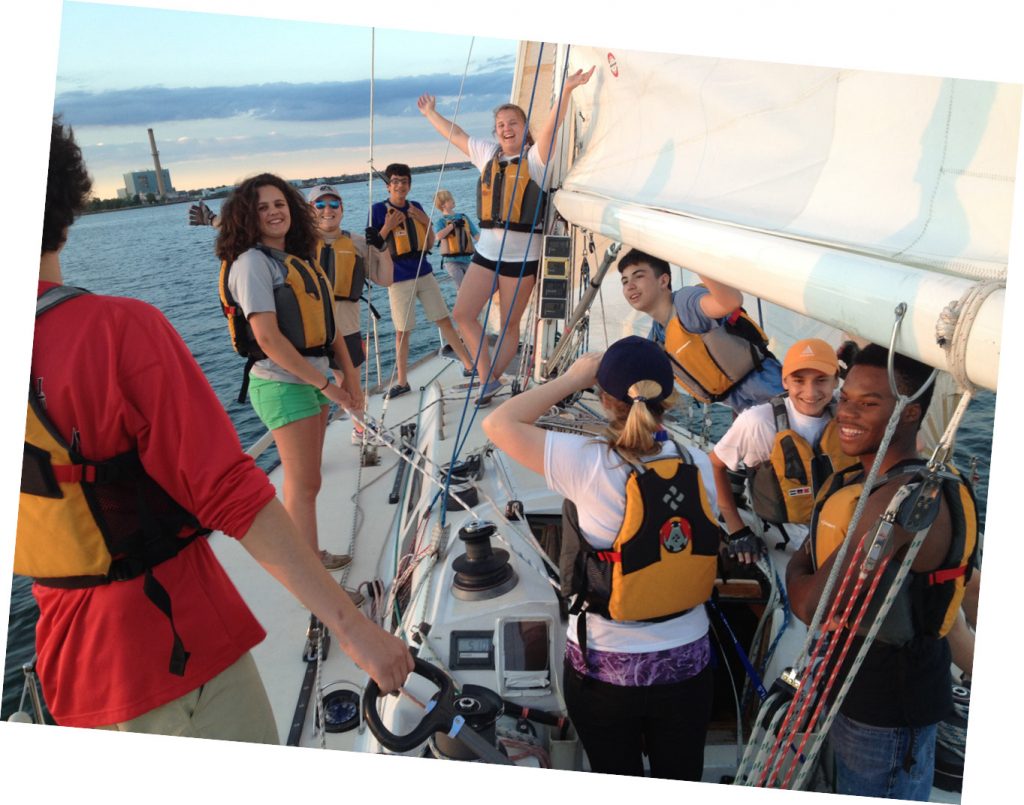
Sea Scout Ship 6 alumni include engineers, marine biologists, commercial ship captains, sail designers, naval architects, and sailors in the U.S. Coast Guard and U.S. Navy. © Kai Horan
In those five innocuous words, anyone with any experience will quickly tell you about the myriad of different backgrounds, alternate experiences, complicated problems, extensive planning, the need for ongoing training and classroom work, on-the-water skilling and drilling, boat maintenance, mechanical repairs, sweat equity, and bloody knuckles; never mind the massive amounts of time and organizational effort, dealing with sacred cows, bruised egos, misplaced pride, perpetual money woes, and factoring in and allowing for alternative value systems and fluid perceptions and ever-changing goals from sponsors, parents, as well as the fluid constituency of today’s modern teenage sailors…
The previous three editions of WindCheck featured story lines that focused on different pathways for teenagers to learn how to enjoy sailing boats that are significantly larger than the traditional Optis, Lasers, 420s and Ideal 18s, while doing it in a thoughtful, engaging, interesting, responsible and safe manner. Some of the common overlapping elements in these successful programs include first making the learning process fun. The best programs create room and opportunity for their juniors to make mistakes (without raised voices, ahem). Then sailing mentors thoughtfully discussing how and what went wrong, with the young sailors suggesting and testing different ways to avoid repeating the problem. One not so obvious commonality is across the best of the profiled youth big boat sailing programs, all cited the critical need to involve and integrate young men – and even more importantly young women – into big boat sail training and how crucial it is to ensure that there are no gender distinctions in any of the roles on the boat.
Successful programs build teams of sailors, not just teams of mostly young males and a few females thrown in for equity’s sake. Statistically, the sport of sailing clearly has a huge opportunity to grow and flourish if women are not only included, but made to feel welcome. That is just the first step over the transom to success. More important is to make a conscious, concerted commitment to women being an integral part of the crew, especially when it comes to critical roles like navigation, tactics, helming and sail trim, not just being a body on the high side – or worse, being tasked with making lunch, getting drinks, or provisioning the boat for a race! Now, more than ever, it is time to eliminate that outmoded stereotype. Peter Becker, founder of the Young American Sailing Foundation and Academy, is adamant that his best teams always have skilled young women in key positions, anywhere and everywhere on the boat.
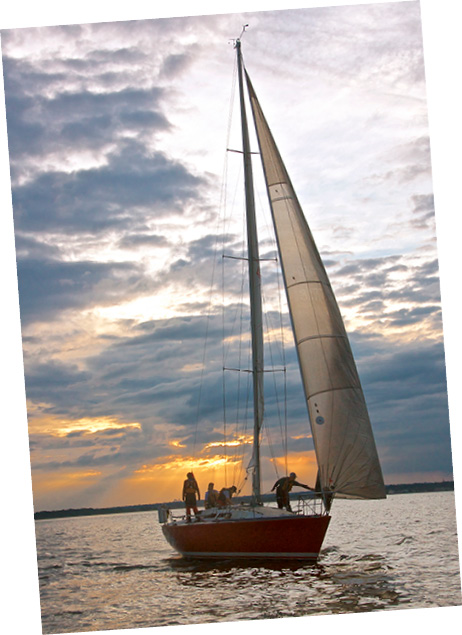
An evening sail on Celebration II © Rick Bannerot/OntheFlyPhoto.net
Lest we not forget what women like Tracy Edwards and Dawn Riley showed the sailing world over thirty years ago what a motivated, well-trained crew of young women can do in big, fast bluewater racing machines! They emphatically demonstrated their skills and capabilities to manage and competitively sail the Farr-designed 58-foot Maiden in the Whitbread Round the World Race in 1990. Four years later Dawn Riley was skipper of Heineken, the Farr 60 in the 1994 Whitbread, and then on to the Eric Goetz-built Mighty Mary in the 1995 America’s Cup Defender series.
Consistently being fast and competitive in big boat sailing is almost always a matter of brains-over-brawn. If the thought process is clear and deliberate, the need for brute force is greatly reduced because the right sails are pre-selected, and the boat is helmed in such a way that precise control supersedes raw speed. Calmly noting and communicating wind oscillations, consulting with the tactician and foredeck hands about impending changes of course, and calling out the planned changes do not require brawn; they are the hallmark of a leader. Spinnakers get flown with more dexterity, and practicing sail changes in a variety of wind conditions reduces accidental round-ups. Today, shouting is almost never called for, especially when great sailors lead by quiet example, leaving little room anymore for “Teddy Terrifics” and “Dennis the Menaces.” Unfortunately, traditions die hard in big boat sailing. The lessons of Captain Bligh in 1789 are still being relearned 230+ years later!
Simply put, good leadership, smart decision-making, well-practiced teamwork, any confidence based on experience, respect and trust must be earned. In the realm of junior big boat sailing, where does one find the opportunity gain these excellent set of skills and experience? One need look no further than Lord Baden-Powell, who in 1910 recognized such a need and started Sea Scouts, just two years after he founded the Boy Scouts.
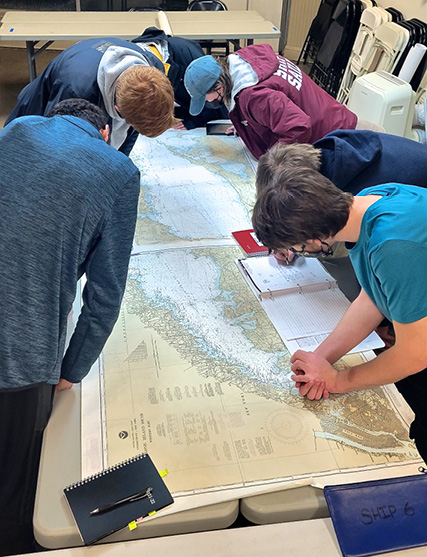
Chart reading practice © Rick Bannerot/OntheFlyPhoto.net
Unlike most junior summer sailing programs at yacht clubs and sailing centers, Sea Scouts is an immersive, year-round program with a myriad of activities and training on the hard, as well as on the water. Sea Scouts use the word “Ship,” not “Troop,” to describe each group. (A point of pride within Sea Scouts, {along with Venturing}, is that they were the first branch of Scouting to go co-ed back in 1971, 45 years before BSA admitted young women.)
Ship 6, based in Norwalk, CT, sails from April to November, as often as three times a week. They go for overnight sails and weeklong cruises, and participate in local round-the-buoy races, middle distance races (40 to 50nm), and long-distance races (well over 100nm). They often have a social boat rendezvous with other Sea Scout Ships (called a GAM in marine parlance), and participate in fundraisers and a variety of coastal marine conservation activities. Ship 6 regularly sails between 800 and 1,200nm every year. (For an idea of how well Ship 6 does in races, against mostly adult-crewed boats, check out the sidebar highlighting some of their accomplishments over the past decade.)
Sailing is certainly a big portion of Sea Scouts and Ship 6, but it is so much more than just a chance to go sailing. The Scouts learn and practice through holistic, peripatetic, hands-on experiences: boat maintenance, marine engine repair, emergency life raft deployment, effective emergency signal flare deployment, boat rigging, sail making, First Aid, CPR, knot tying, overboard rescue drills, traditional chart and electronic navigation skills, reading marine instruments, the proper use of various marine radio communications…and the list goes on.
What do Sea Scouts do in their free time? Other than school and homework, Ship 6 is currently helping build an underwater ROV (remotely operated vehicle) at the University of Bridgeport, proving that Sea Scouts is an immersive experience. They get to tour colleges with marine studies and active sailing programs, have guided tours of the Intrepid Sea, Air & Space Museum in New York, NY, and explore the rich sailing history and boats at Mystic Seaport Museum in Mystic, CT.
Part of what makes Sea Scouts unique is that it is peer-led, with direction and advice from adult volunteers. There is a particular emphasis on developing leadership skills, mentoring, learning effective teaching skills, and solving problems. A Sea Scout Ship is more than just a group of young sailors; it is both land-based and a water-oriented classroom. Scouts essentially learn how to manage and run a small business including everything from marketing and communications to budgeting, managing cash flow, and accounting.
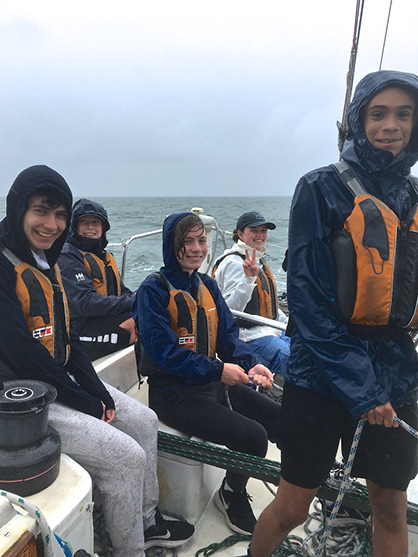
Smiling in the rain © Kai Horan
This is, in part, because their charter involved organizational help from the U.S. Secretary of the Navy. Sea Scouts includes progressive ranks, gained by age and experience starting with Apprentice, then Ordinary, Able, and finally the highly coveted title of Quartermaster. (For comparison, .05% of Boy Scouts become Eagle Scouts. In Sea Scouts, only .005% make Quartermaster!) As part of the structure of the Ship, there are also ranks related to responsibilities in running the Ship, including amongst others: Assistant Crew Leader, Specialist, Boatswain Mate, Purser, and Yeoman. Age ranges are from 14 to 18 (although some Ships have Scouts up to 21), for boys and girls.
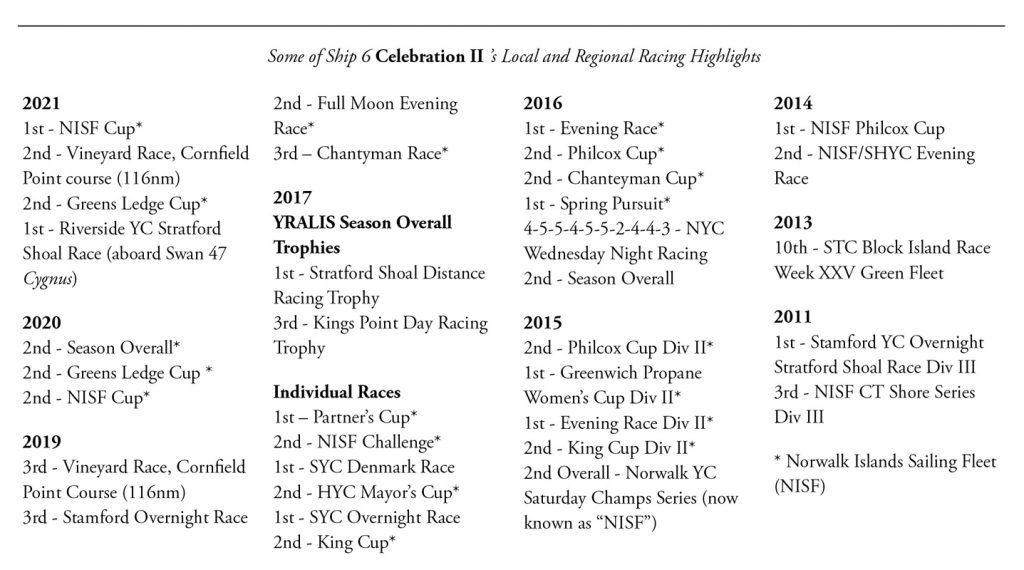
Like other forms of scouting, Sea Scouts is not expensive to join. However, for the Ships that have boats like Ship 6’s bright red Tripp 37 Celebration II, fundraising is a crucial element. Local support comes in many forms, from sailmakers to parts suppliers, riggers and maintenance experts, from the Norwalk Sail & Power Squadron, and marine centers like the Gardella family’s Rex Marine Center and Norwalk Cove Marina who provide invaluable boat storage, an in-water berth, meeting rooms, and marine resources for maintaining a well-built bluewater racer/cruiser in Bristol condition.
The head volunteer is called the Ship’s Skipper, and Ship 6’s current Skipper is Kai Horan. She came in as a Mate (the name for an assistant adult volunteer), back in 2005, but soon found herself assuming the role of Skipper, and has done a remarkable job ever since. Horan’s boating experience includes racing JY15s, J/24s and an Ensign. She has sailed in more than ten Vineyard Races, Block Island Race Week, Stratford Shoal Races, and many more around Long Island Sound. She has also done extended cruising in Maine on a 44-foot steel-hulled sloop. Kai is a Past Commander of the Norwalk Sail & Power Squadron, and completed courses through and including Advanced Piloting. She is Sea Scout Leader-trained, been a staff instructor several times at Sea Badge adult leadership conferences, and is a recipient of the Sea Scout Venturing Leadership and Unit Leader of Merit awards.
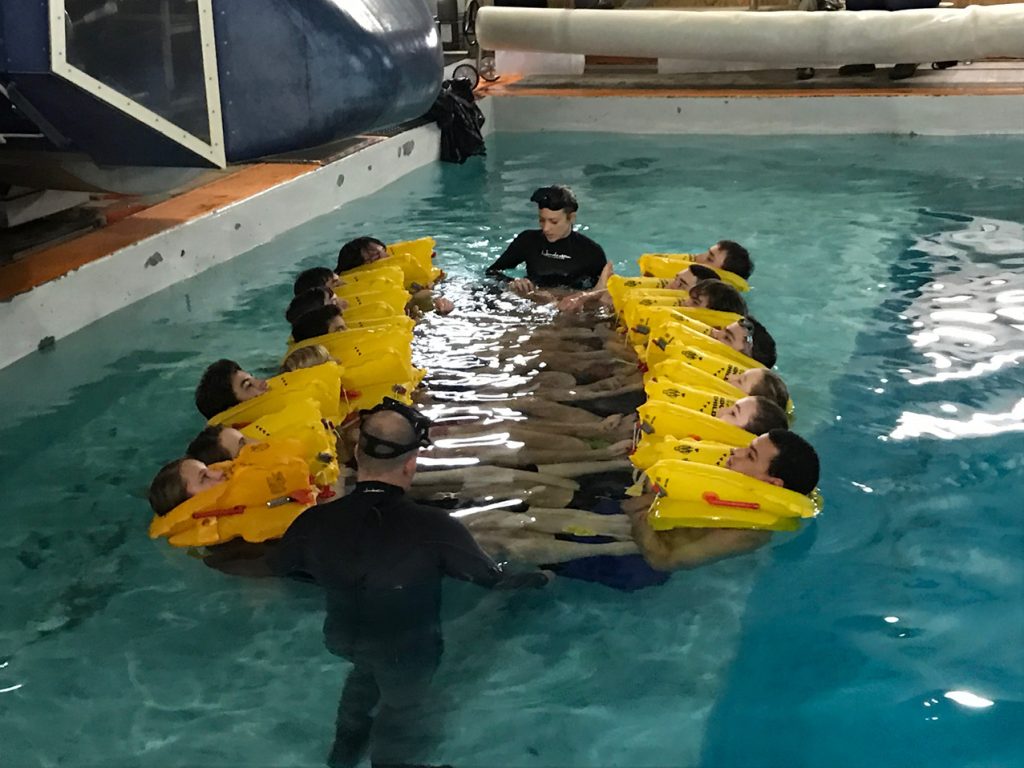
Emergency swimming drill © Kai Horan
Under Kai’s watch, Ship 6 has produced a remarkable array of accomplished young men and women who have gone on to race sailboats in college, and in both amateur and professional sailing. In the maritime industries and professions, Ship 6 counts amongst its alumni engineers, marine biologists, commercial ship captains, sail designers, naval architects, and sailors in the U.S. Coast Guard and U.S. Navy.
One such alumni example goes back to 2013, when a 16-year-old Sea Scout wrote in WindCheck about his first experience racing in fog and heavy swells at Block Island Race Week
(windcheckmagazine.com/article/2013_aug_sea_scout_ship_6_tackles_block_island_race_week/):
“We faced a daunting challenge on the last day. The weather had deteriorated, and we were looking at a race in 10-foot swells and fog that cut visibility to 100 yards. The idea of sailing in those conditions was crazy to me; the idea of racing in those conditions was beyond my comprehension. Sailing in the reduced visibility and finding marks, boats and land was a challenge unlike any I’ve ever experienced. Despite the swells and the disorienting fog, we sailed a good race and I’m happy that I was on the boat. It was a good experience, and now whenever I sail on Long Island Sound I’m not intimidated by 4-foot waves and 20 knots of breeze.” – Michael Barnaba, 16
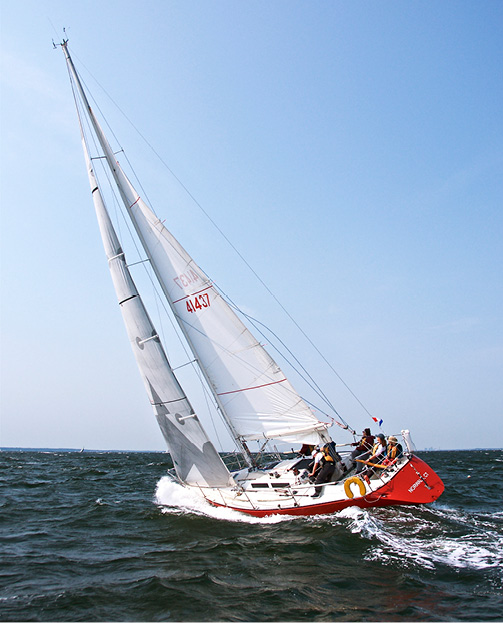
Celebration II has posted some strong race results, mostly against adult-crewed boats. © Rick Bannerot/OntheFlyPhoto.net
A year later Michael penned a full-length follow-up in WindCheck on a big GAM with fifteen other Sea Scout Ships at Norwalk’s Sheffield Lighthouse. Clearly the experience at Race Week added to his confidence and leadership skills (windcheckmagazine.com/article/sea_scout_squadron_gam_2014/):
“Once we had all the Scouts on the island, the weekend’s program began. The day started with a quick introduction of all the Ships, a safety briefing, and group assignments. Once that was squared away, we quickly moved into our activities, all of which were meticulously planned. They were designed to teach important maritime skills and to encourage social interaction between Scouts from different Ships. We planned navigation skills, rowing, hiking, man-overboard drills, and everybody’s favorite, distress signal training. Those with less experience benefited from the chartwork and the man-overboard activities.”
Flash forward to present day and it is clear that Sea Scouts (and in particular Ship 6) made a lasting impression on Michael Barnaba. He recently checked in with Kai and the Scouts of Ship 6 with an email update:
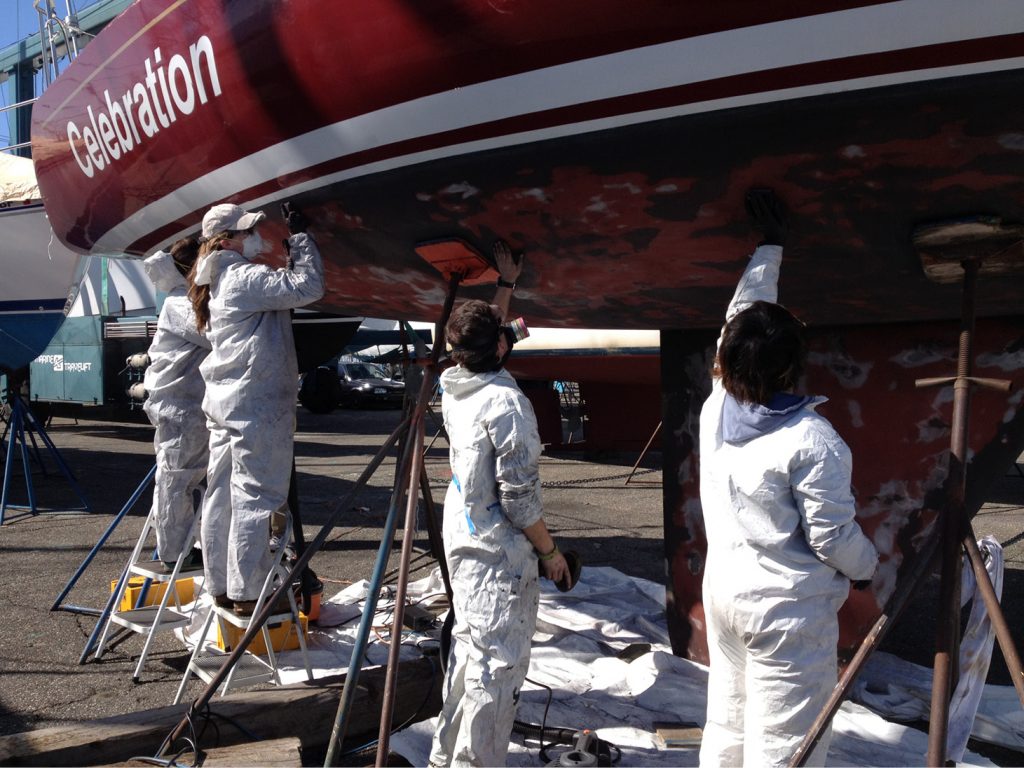
Ship 6 Sea Scouts learn big boat sailing from the bottom up. © Kai Horan
“I graduated from Texas A&M with a degree in Marine Engineering, and a 3rd Assistant Engineer’s license. I then enlisted in the Navy and spent the past three years as the Anti-Terrorism Officer on USS Gridley out of Everett, WA. Recently I transferred and started my new job in San Diego as Navigator on USS Lake Erie, a Ticonderoga Class Guided Missile Cruiser. Keep kicking (butt) and doing great things! The knowledge and work ethic I know you’re imparting to the team is priceless (because God knows I needed it and got it!)
– Mike
For additional information about Ship 6, email norwalkship6@gmail.com or log onto norwalkship6.org and facebook.com/NorwalkShip6. ■
(Editor’s Note: Look for our next installment in the many pathways to finding one’s salt as we explore the wonderful world of
SoundWaters and their ever-growing Young Mariners Program that focuses on helping at-risk youth get from the concrete and glass of urban schools into the marine world we know and love.)




